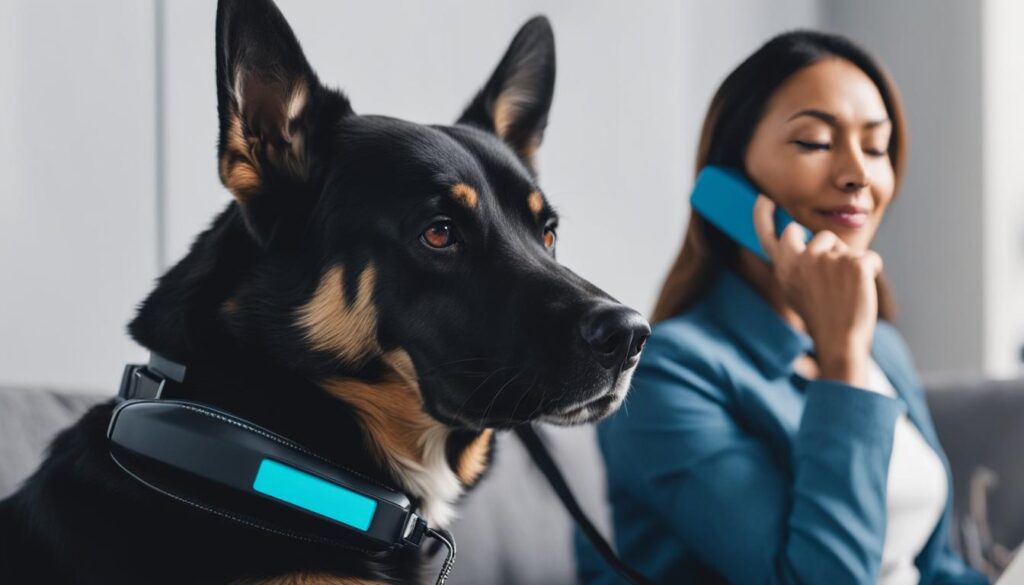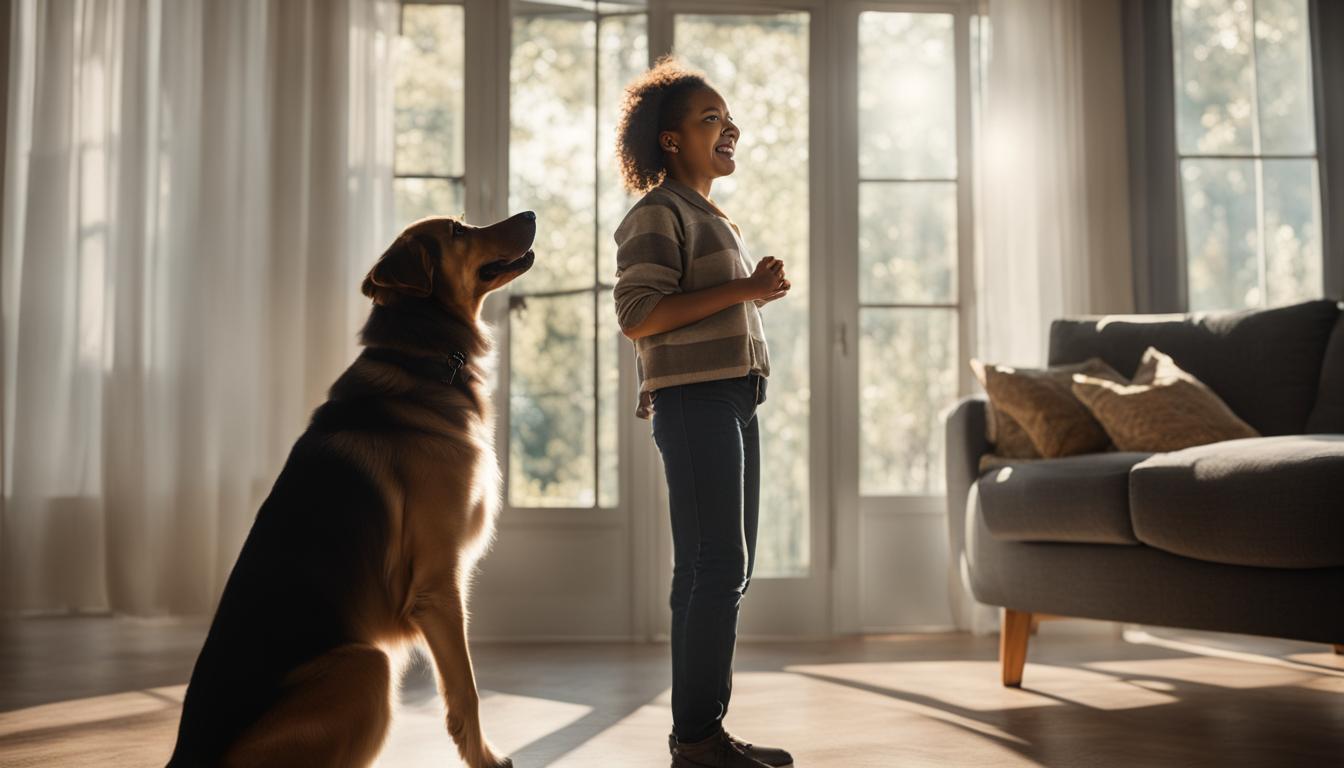Do you ever wonder Why Does My Dog Talk Back to Me? It's not uncommon for dogs to communicate in their own unique way, and understanding their behavior can deepen the bond between you and your furry friend. In this article, we'll explore the reasons behind your dog's talking back and provide valuable insights into the world of dog communication.
Key Takeaways : Why Does My Dog Talk Back to Me
- Dogs use vocalizations such as barks, whines, and growls to convey their emotions.
- Paying attention to your dog's body language and vocal cues can help you interpret their communication style.
- Training is crucial in addressing talking back behavior, with positive reinforcement methods being more effective than punishment.
- Talking back can sometimes be a sign that your dog is seeking attention or trying to communicate their needs.
- By understanding your dog's behavior and communication style, you can strengthen the bond between you.
Dogs Use Vocalizations to Convey Emotions
Dogs have a unique ability to vocalize and use a variety of sounds to communicate their emotions and needs. Understanding these vocalizations can provide valuable insights into your dog's state of mind and help foster better communication between you and your furry friend.
When it comes to dog vocalizations, barks, whines, and growls are among the most common sounds. Each of these vocalizations carries its unique meaning and can indicate different emotions or intentions.
Barks
Barking is perhaps the most well-known and widely recognized form of dog vocalization. Dogs bark for various reasons, including alerting their owners to potential threats, expressing excitement, or seeking attention. The pitch, volume, and duration of a bark can provide helpful clues about a dog's emotional state.
“Barking is not a single, universal language; it is open to interpretation based on context and accompanying body language. A high-pitched bark may suggest excitement or playfulness, while a deep, relentless bark could indicate alarm or aggression.”
Whines
Whining is commonly associated with puppies but can be observed in dogs of all ages. Whining is a high-pitched vocalization that dogs use to express a range of emotions, such as fear, anxiety, frustration, or even pain. Understanding the context in which your dog is whining, along with their body language, can provide important insights into their underlying emotions.
Growls
Growling is typically seen as a warning sign from a dog. It can convey feelings of fear, threat, or discomfort. By growling, dogs try to communicate their boundaries and express their desire to be left alone. However, it's important to note that not all growls indicate aggression, and they should be interpreted in conjunction with other behavioral cues.


Interpreting Dog Vocalizations
Decoding dog vocalizations requires paying attention to the specific context, accompanying body language, and overall behavior displayed by your dog. Here are a few general guidelines to help you interpret your dog's vocalizations:
- Observe the pitch, volume, and duration of the vocalization.
- Take note of the circumstances and triggers that elicit the vocalization.
- Consider your dog's body language, such as tail wagging, ear position, and overall posture.
- Identify any other behavioral cues, such as growling, pacing, or cowering.
By analyzing these factors, you'll be better equipped to understand what your dog is trying to communicate. Remember, every dog is unique, and their vocalizations may vary. Building a strong bond with your dog and spending quality time together will further enhance your ability to interpret their vocalizations accurately.
Dog Communication and Human Interaction
Dogs have an incredible ability to understand human words and tone of voice. It's as if they can have a conversation with us through their vocalizations and responses. When we pay attention to their body language and vocal cues, we can interpret their communication and strengthen the bond between dogs and their owners.
Just like humans, dogs use a combination of vocalizations and body language to express themselves and convey their needs. By observing their behavior closely, we can decipher their messages and ensure effective dog-human communication.
When dogs communicate with us, they may use different vocalizations such as barks, whines, and even howls. These vocal cues can provide valuable insights into their emotions and intentions. For example, a high-pitched whine might indicate excitement or anticipation, while a low growl could signify caution or fear. By paying attention to these vocal cues, we can better understand our furry friends.
In addition to vocalizations, dogs also communicate through their body language. Tail wagging, ear position, and facial expressions are all ways they convey their feelings and intentions. An erect tail and relaxed body indicate a happy and friendly mood, while a tucked tail or raised hackles could suggest fear or aggression. By observing these subtle cues, we can respond appropriately and create a positive and safe environment for our dogs.
Understanding and interpreting canine responses is essential for building a strong and trusting relationship with our dogs. By actively engaging in their communication style, we can enhance the dog-human bond and provide them with the emotional support they need.
Body Language and Vocal Cues
Interpreting a dog's body language and vocal cues requires careful observation and knowledge of their typical behaviors. Here are some key indicators to keep in mind:
| Behavior | Meaning |
|---|---|
| Tail wagging | Happy and friendly |
| Tail tucked | Fear or submission |
| Ears forward | Alert and interested |
| Ears pressed back | Fear or aggression |
| Relaxed body | Content and comfortable |
| Raised hackles | Agitated or defensive |
By familiarizing ourselves with these cues and their meanings, we can better understand what our dogs are trying to communicate to us.


Remember, effective dog-human communication is a two-way street. Not only should we pay attention to their vocalizations and body language, but we should also respond in a way that acknowledges their communication efforts. Engaging in regular training, providing mental and physical stimulation, and addressing their needs are all crucial elements of fostering a strong bond with our four-legged companions.
Continue reading the next section to discover the reasons behind dogs talking back and effective strategies for addressing this behavior.
Reasons for Dogs Talking Back
Dogs are known for their ability to communicate with their owners through various vocalizations and behaviors. Sometimes, it may seem like our dogs are talking back to us. Understanding the reasons behind this behavior can shed light on their canine nature and help us address any underlying concerns. Let's explore some of the common motivations behind dogs talking back.
Seeking Attention and Bonding
One of the primary reasons dogs talk back to their owners is because they are seeking attention. Dogs thrive on human interaction and may vocalize to get our focus on them. It could be their way of saying, “Hey, pay attention to me!” Talking back can also be a way for dogs to bond with their owners and establish a deeper connection.
Expressing Refusal or Discomfort
Dogs may also talk back when they want to express their refusal or discomfort. It could be a response to a command or action they are not fond of. For example, if you ask your dog to get off the couch, and they bark or whine in response, it could be their way of saying, “I don't want to.” Paying attention to their vocalizations and body language can help us understand if they are communicating their refusal.
Showing Possessiveness or Intimidation
Dogs may use talking back as a way to show possessiveness or intimidate others. They may growl or bark defensively when someone approaches their food bowl or toys. These vocalizations serve as a warning to others, signaling that they want to protect their resources. Understanding this behavior can help us manage their possessiveness and create a safe environment.
By recognizing these reasons for dogs talking back, we can better understand their needs and motivations. It is important to remember that dogs communicate differently from humans, and their vocalizations are an essential part of their canine behavior and psychology. With proper training and guidance, we can address this behavior and strengthen our bond with our furry companions.
| Reasons for Dogs Talking Back | Description |
|---|---|
| Seeking Attention and Bonding | Dogs talk back to gain attention and establish a deeper bond with their owners. |
| Expressing Refusal or Discomfort | Dogs may vocalize to express their refusal or discomfort with a command or situation. |
| Showing Possessiveness or Intimidation | Dogs use vocalizations to show possessiveness and intimidate others in certain situations. |
To further understand and address dogs talking back, it is beneficial to consult professional trainers or animal behaviorists. They can provide valuable insights and guidance on dog psychology and training techniques tailored to your specific dog's needs.
Interpreting Different Forms of Talking Back
When it comes to dogs talking back, each furry friend has their unique way of expressing themselves. To truly understand what they're trying to communicate, it's crucial to pay close attention to their body language and vocal cues. This allows us to decode their language and interpret their behavior effectively.
Some dogs may talk back in an aggressive manner, displaying signs of dominance or assertiveness. They may bark loudly, growl, or even bare their teeth. On the other hand, some dogs may exhibit fear or confusion when talking back. They may whine or whimper, trying to communicate their discomfort or anxiety.
Recognizing these different forms of talking back is key in determining the best approach to respond. By observing their body language and understanding their vocalizations, we can gain valuable insights into their emotional state and underlying motivations.
It's important to remember that a dog's behavior is the result of their unique personality, experiences, and environment.
For example, if a dog is talking back aggressively, it may be a sign of fear or insecurity rather than outright aggression. By approaching them calmly and giving them space, we can help alleviate their anxiety and build trust. In contrast, if a dog is talking back in a fearful manner, providing reassurance and comfort can help them feel safe and secure.
Ultimately, interpreting the different forms of talking back requires empathy and understanding. By taking the time to observe and interpret their behavior, we can foster a stronger bond and more effective communication with our canine companions.


Understanding dog behavior and decoding their language is an ongoing process. It takes patience, observation, and a willingness to learn. By utilizing these insights, we can deepen our connection with our dogs and enhance their overall well-being.
Training Tips to Address Talking Back
Training is crucial when it comes to addressing talking back behavior in dogs. By establishing consistent rules and boundaries, you can effectively assert your role as the leader in the relationship. Here are some useful tips to help you train your dog and correct their behavior:
1. Use Positive Reinforcement
Positive reinforcement techniques can be highly effective in shaping desired behavior. Reward your dog with treats, praise, and affection when they exhibit good behavior or respond appropriately to commands. This approach encourages dogs to associate positive outcomes with the desired behavior, making them more likely to repeat it.
2. Be Consistent and Clear
Dogs thrive on consistency and clarity. Ensure that your commands and expectations are communicated consistently and clearly. Use clear verbal cues and hand signals to convey your intentions. Consistency in your training methods and expectations will help your dog understand what is expected of them and reduce confusion.
3. Ignore Undesired Behavior
When your dog engages in talking back behavior, such as barking or whining for attention, it's important not to reinforce the behavior with attention or punishment. Instead, ignore it and wait for a moment of silence or calm behavior. Then, reward their quiet and composed behavior with attention or treats. This approach teaches your dog that being calm and quiet is the desired behavior for attention.
4. Redirect and Distract
If your dog tends to talk back or exhibit inappropriate behavior in specific situations, preemptively redirect their attention to more appropriate activities. For example, if your dog usually barks at passersby, redirect their focus with a favorite toy or engage them in obedience training exercises. This helps divert their energy and attention to more positive outlets.
| Training Tips | Effectiveness |
|---|---|
| Use positive reinforcement | Highly effective |
| Be consistent and clear | Essential for success |
| Ignore undesired behavior | Can be effective if consistently applied |
| Redirect and distract | Useful for managing behavior in specific situations |
Remember, dog training requires patience and persistence. Consistently applying positive reinforcement techniques and setting clear boundaries will yield the best results in addressing talking back behavior. Seek professional guidance from a certified dog trainer if you encounter any challenges or need personalized training advice.


Providing Attention and Addressing Dog's Needs
Dogs are social animals that rely on interactions with their owners to fulfill their emotional and physical needs. When dogs talk back, it is often their way of seeking attention or communicating their needs. As pet owners, it is essential to listen and address their needs to maintain a healthy and harmonious relationship.
One way to provide attention is by spending quality time with your dog. Engage in activities that they enjoy, such as playing fetch, going for walks, or simply cuddling on the couch. By actively participating in these activities, you not only help fulfill their need for physical exercise and stimulation but also strengthen the bond between you and your furry friend.
Addressing your dog's needs goes beyond physical interaction. They may also talk back to communicate their basic needs, such as hunger or thirst. Make sure to provide a nutritious and balanced diet, and always keep their water bowl filled. Regular feeding times and portion control can help establish a routine that satisfies their physiological needs.
Additionally, mental stimulation is crucial for a dog's overall well-being. Incorporating puzzle toys, interactive games, and training sessions can help keep their minds active and prevent boredom, which can lead to undesirable behaviors like excessive barking or chewing. By providing mental stimulation, you help fulfill their cognitive needs and keep them engaged and content.
“Understanding and addressing your dog's needs not only reduces talking back but also enhances their overall happiness and satisfaction.”
It's important to note that each dog is unique, and not all talk back in the same way or for the same reasons. Paying attention to their body language, vocal cues, and individual preferences will help you better understand and address their specific needs. Remember, open communication, patience, and empathy are key to fostering a strong connection with your canine companion.
Benefits of Providing Attention and Addressing Dog's Needs:
- Promotes a strong bond between you and your dog
- Reduces talking back and other undesirable behaviors
- Enhances your dog's overall happiness and well-being
- Fulfills their emotional, physical, and mental needs
- Creates a harmonious and mutually fulfilling relationship
Summary:
Understanding dog behavior, dogs communicating with owners, and providing attention to their needs are essential aspects of building a meaningful relationship with your furry companion. By actively listening and addressing their physical, emotional, and mental needs, you can reduce talking back and strengthen the bond you share with your dog.
Conclusion
Dogs have a unique way of communicating with their owners, and talking back is a behavior that can be understood and addressed. By paying close attention to their vocalizations, body language, and underlying motivations, we can gain valuable insights into their communication style and strengthen the bond with our furry friends.
Interpreting dog behavior starts with recognizing the different vocalizations they use to convey their emotions. Whether it's a playful bark, an anxious whine, or a growl to show dominance, understanding these vocal cues can help us better understand what our dogs are trying to communicate.
Furthermore, dog-human interaction plays a vital role in their communication. Dogs possess a remarkable ability to understand human words and tone of voice, and they often respond with their own vocalizations. By paying attention to their responses and engaging in a sort of conversation, we can foster a deeper connection with our canine companions.
To address talking back behavior, training is key. Establishing consistent rules and boundaries, along with positive reinforcement techniques, can help shape the desired behavior in our dogs. By rewarding their good behavior and providing the attention and care they need, we can create a harmonious relationship based on trust and understanding.
FAQ
Why does my dog talk back to me?
Dogs have various ways of communicating with their owners, and sometimes it may seem like they are talking back. They use vocalizations to convey their emotions and engage in a sort of conversation with their owners.
How do dogs use vocalizations to convey emotions?
Dogs use barks, whines, and growls to communicate their emotions. For example, a high-pitched whine may indicate anxiety or fear, while a deep bark could signify aggression or dominance.
What is the importance of dog communication and human interaction?
Understanding how dogs communicate and engaging in effective communication with them is crucial for strengthening the dog-human bond. Paying attention to their vocal cues and body language helps interpret their responses and needs.
What are the reasons for dogs talking back?
Dogs may talk back to seek attention, bond with their owners, refuse to do something, or show possessiveness or intimidation. Understanding the underlying motivations can help address the behavior.
How can different forms of talking back be interpreted?
Each dog is unique in how they talk back, and it is essential to pay attention to their body language and vocal cues for proper interpretation. Talking back can manifest as aggression, fear, confusion, or other behaviors.
What are some training tips to address talking back?
Training is crucial in addressing talking back behavior. Establishing consistent rules and boundaries, using positive reinforcement methods, and rewarding desired behavior can be effective in curbing talking back.
How can providing attention and addressing dog's needs help reduce talking back?
Dogs may talk back to communicate their needs. Taking the time to listen and address their needs, such as providing food, water, or mental stimulation, can reduce talking back and strengthen the bond with your dog.
How can understanding dog behavior and communication benefit dog-human interaction?
Understanding dog behavior and communication patterns allows for better interpretation and response to their needs and emotions. This enhances the dog-human interaction and strengthens the bond between the two.





